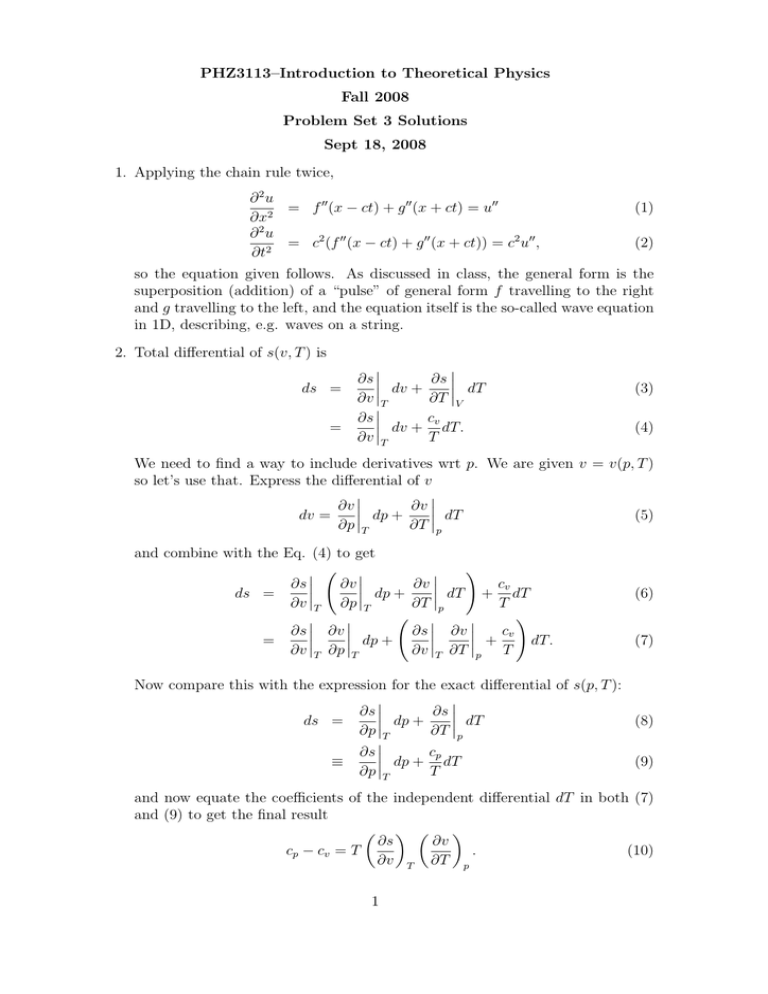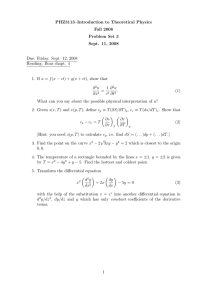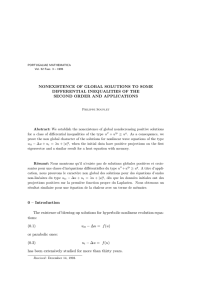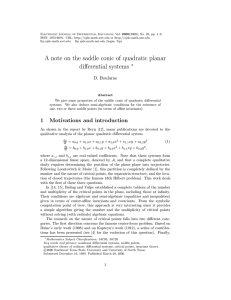PHZ3113–Introduction to Theoretical Physics Fall 2008 Problem Set 3 Solutions Sept 18, 2008
advertisement

PHZ3113–Introduction to Theoretical Physics Fall 2008 Problem Set 3 Solutions Sept 18, 2008 1. Applying the chain rule twice, ∂ 2u = f 00 (x − ct) + g 00 (x + ct) = u00 ∂x2 ∂ 2u = c2 (f 00 (x − ct) + g 00 (x + ct)) = c2 u00 , ∂t2 (1) (2) so the equation given follows. As discussed in class, the general form is the superposition (addition) of a “pulse” of general form f travelling to the right and g travelling to the left, and the equation itself is the so-called wave equation in 1D, describing, e.g. waves on a string. 2. Total differential of s(v, T ) is ds = = ¯ ¯ ∂s ¯¯ ∂s ¯¯ dv + dT ∂v ¯T ∂T ¯V ¯ ∂s ¯¯ cv dv + dT. ¯ ∂v T T (3) (4) We need to find a way to include derivatives wrt p. We are given v = v(p, T ) so let’s use that. Express the differential of v ¯ ¯ ∂v ¯¯ ∂v ¯¯ dv = dp + dT (5) ∂p ¯T ∂T ¯p and combine with the Eq. (4) to get ! ¯ à ¯ ¯ ∂s ¯¯ ∂v ¯¯ ∂v ¯¯ cv ds = dp + dT + dT ¯ ¯ ¯ ∂v T ∂p T ∂T p T à ! ¯ ¯ ¯ ¯ ∂s ¯¯ ∂v ¯¯ ∂s ¯¯ ∂v ¯¯ cv = dp + + dT. ∂v ¯T ∂p ¯T ∂v ¯T ∂T ¯p T (6) (7) Now compare this with the expression for the exact differential of s(p, T ): ¯ ¯ ∂s ¯¯ ∂s ¯¯ dp + dT (8) ds = ∂p ¯T ∂T ¯p ¯ ∂s ¯¯ cp ≡ dp + dT (9) ¯ ∂p T T and now equate the coefficients of the independent differential dT in both (7) and (9) to get the final result µ ¶ µ ¶ ∂s ∂v cp − cv = T . (10) ∂v T ∂T p 1 p 3. We’re looking for the point (x, y) where the√distance from the origin x2 + y 2 2 2 2 2 is minimal subject p to the constraint x − 2 3xy − y = 2. Note that if x + y 2 2 is a minimum x + y will be too. You can do this problem with the method of Lagrange multipliers described in Boas ch. 4, or by substituting the solution for y in terms of x, √ √ √ y = − 3x − ± 2 2x2 − 1 (11) into x2 + y 2 . One then needs to minimize x2 + y(x)2 , or find the x such that à ! √ ´ √ √ √ ³ √ 2 2x 2 2x + 2 ± √ − 3x ± 2 2x − 1 = 0 (12) − 3 2x2 − 1 This can be simplified and solved for x, then √ the value for x substituted back to find y. The two solutions are (x, y) = (∓ 3/2, ±1/2). 4. Here’s a plot of the rectangle We want the temperature to be an extremum both 2 1 0 -1 -2 -1 -0.5 0 0.5 1 Figure 1: Temperature in rectangle. Note dark blue is cold and violet is hot. along x and along y, i.e. the gradient ∇T = 0 at these points. ∇T = (2x, 1 − 8y) = 0. (13) Now remember in 2D the stationary point (0, 1/8) which solves these equations need not be an absolute min or max. To check we need the second derivatives ∂ 2T =2; ∂x2 ∂ 2T =0; ∂x∂y ∂ 2T = −8, ∂y 2 (14) so the signs of the curvature in x and y directions are different, indicating a saddle point. In the picture you can see this saddle point pretty clearly if you view it in color. Now if there is no absolute min/max in the interior of the rectangle, it must take place on the boundaries. On x = −1, T (−1, y) = −4 + y − 4y 2 , and 2 the extrema are at dT (−1, y)/dy = 0 or y = 1/8 which has second derivative d2 T (−1, y)/dy 2 |y=1/8 = −8, indicating a max. The “temperature” at this point is T (−1, 1/8) = −63/16. There’s another equivalent maximum at (1, 1/8). Now look on top and bottom. T (x, −2) = −23 + x2 so dT (x, 2)/dx = 0 gives 2x = 0 and d2 T (x, 2)/dx2 |x=0 = 2, so a min wrt x. At (0, −2) the temperature is T = −23. A similar analysis shows that there’s a min on the top too, but the one on the bottom is lower. 5. Want to use the substitution x = ez and transform the differential equation µ 2 ¶ µ ¶ dy dy 2 x − 5y = 0 (15) + 2x 2 dx dx The chain rule gives dy(x(z)) dy dx dy dy = = ez =x dz dx dzµ dx ¶dx 2 d2 y d dy d y dy 2 = x x = x +x 2 2 dz dx dx dx dx (16) (17) so you can see that by adding the two you get on the right hand side the first two terms of the original differential equation, which can thus be expressed as d2 y dy + − 5y = 0 dz 2 dz 3 (18)









